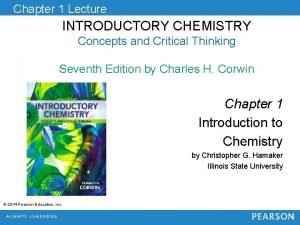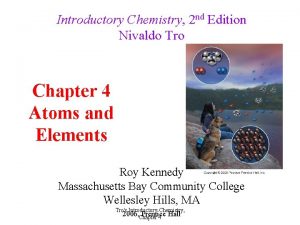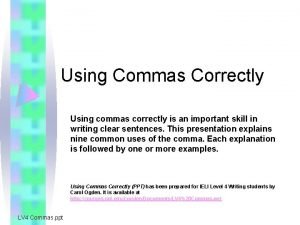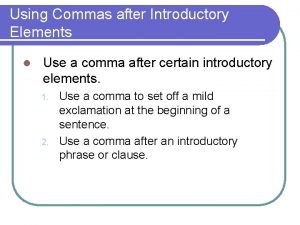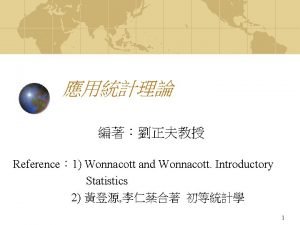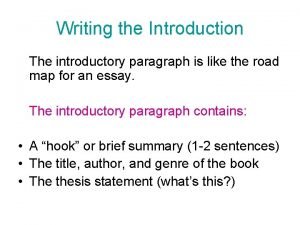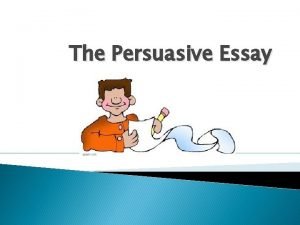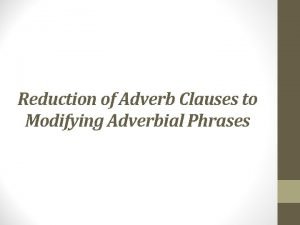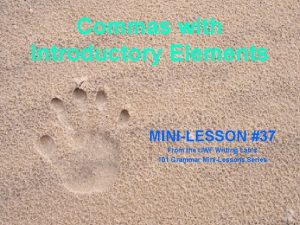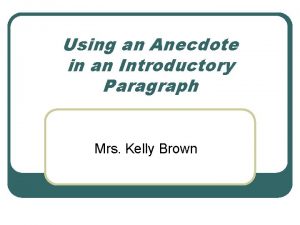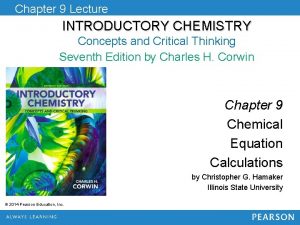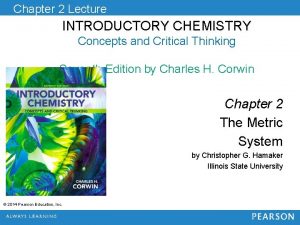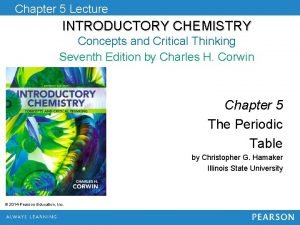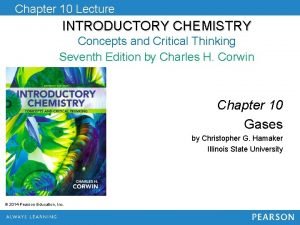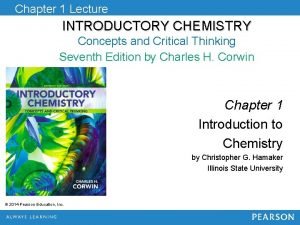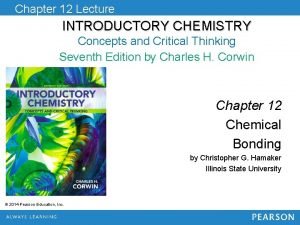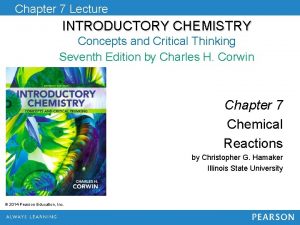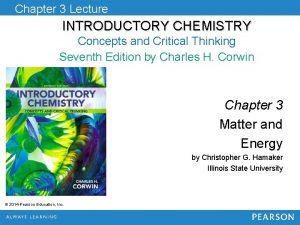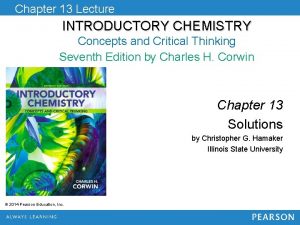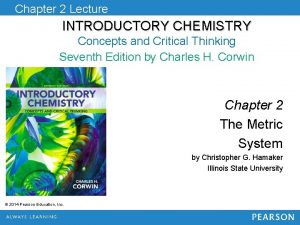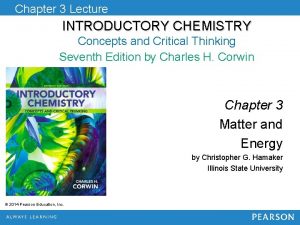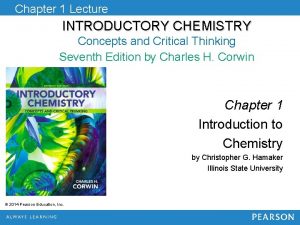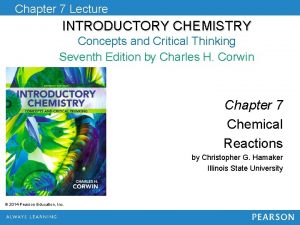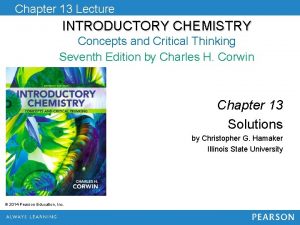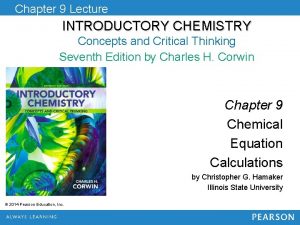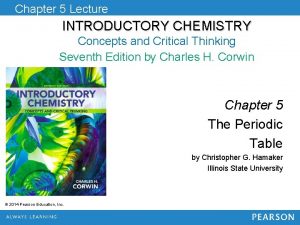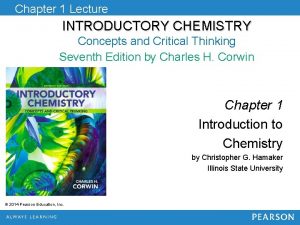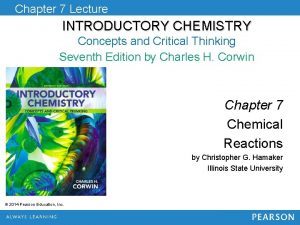Chapter 13 Lecture INTRODUCTORY CHEMISTRY Concepts and Critical






































- Slides: 38

Chapter 13 Lecture INTRODUCTORY CHEMISTRY Concepts and Critical Thinking Seventh Edition by Charles H. Corwin Chapter 13 Solutions by Christopher G. Hamaker Illinois State University © 2014 Pearson Education, Inc.

Solutions • A solution is a homogeneous mixture. • A solution is composed of a solute dissolved in a solvent. • Solutions exist in all three physical states: © 2014 Pearson Education, Inc. Chapter 13

Gases in Solution • Temperature affects the solubility of gases. • The higher the temperature is, the lower the solubility of a gas is in solution. • An example is carbon dioxide in soda: – Less CO 2 escapes when you open a cold soda than when you open a warm soda. © 2014 Pearson Education, Inc. Chapter 13

Pressure and Gas Solubility • Pressure also influences the solubility of gases. • According to Henry’s law, the solubility of a gas is directly proportional to the partial pressure of the gas above the liquid. • If we double the partial pressure of a gas, we double the solubility. © 2014 Pearson Education, Inc. Chapter 13

Henry’s Law • We can calculate the solubility of a gas at a new pressure using Henry’s law. solubility × new pressure = new solubility old pressure • What is the solubility of oxygen gas at 25 C and a partial pressure of 1150 torr if the solubility of oxygen is 0. 00414 g/100 m. L at 25 C and 760 torr? 0. 00414 g/100 m. L × © 2014 Pearson Education, Inc. 1150 torr = 0. 00626 g/100 m. L 760 torr Chapter 13

Liquids in Solution • When two liquids make a solution, the solute is the lesser quantity, and the solvent is the greater quantity. • Recall that a net dipole is present in a polar molecule. • Water is a polar molecule. © 2014 Pearson Education, Inc. Chapter 13

Polar and Nonpolar Solvents • A liquid composed of polar molecules is a polar solvent. Water is a polar solvent. • A liquid composed of nonpolar molecules is a nonpolar solvent. Hexane is a nonpolar solvent. © 2014 Pearson Education, Inc. Chapter 13

Like Dissolves Like Rule • • Polar solvents dissolve in one another. Nonpolar solvents dissolve in one another. This is the like dissolves like rule. Methanol dissolves in water, but hexane does not dissolve in water. • Hexane dissolves in toluene, but water does not dissolve in toluene. © 2014 Pearson Education, Inc. Chapter 13

Miscible and Immiscible • Two liquids that completely dissolve in each other are miscible liquids. • Two liquids that are not miscible in each other are immiscible liquids. • Polar water and nonpolar oil are immiscible liquids and do not mix to form a solution. © 2014 Pearson Education, Inc. Chapter 13

Solids in Solution • When a solid substance dissolves in a liquid, the solute particles are attracted to the solvent particles. • When a solution forms, the solute particles are more strongly attracted to the solvent particles than to each other. • We can also predict whether a solid will dissolve in a liquid by applying the like dissolves like rule. © 2014 Pearson Education, Inc. Chapter 13

Like Dissolves Like for Solids • Ionic compounds, like sodium chloride, are soluble in polar solvents and insoluble in nonpolar solvents. • Polar compounds, like table sugar (C 12 H 22 O 11), are soluble in polar solvents and insoluble in nonpolar solvents. • Nonpolar compounds, like naphthalene (C 10 H 8), are soluble in nonpolar solvents and insoluble in polar solvents. © 2014 Pearson Education, Inc. Chapter 13

Chemistry Connection: Colloids • Why is the beam of light not visible in the solution, but observed in the colloid? • The solution, at the right of this slide, is a colloid. • A colloid is a solution with large particles (ranging from 1 to 100 nm). • The solute particles in a colloid are large enough to scatter light via a phenomenon known as the Tyndall effect. © 2014 Pearson Education, Inc. Chapter 13

The Dissolving Process • When a soluble crystal is placed into a solvent, it begins to dissolve. • When a sugar crystal is placed in water, the water molecules attack the crystal and begin pulling away the solute. • The sugar molecules are held within a cluster of water molecules called a solvent cage. © 2014 Pearson Education, Inc. Chapter 13

Dissolving of Ionic Compounds • When a sodium chloride crystal is placed in water, the water molecules attack the edge of the crystal. • In an ionic compound, the water molecules pull away positive and negative ions. • The anions are surrounded by the positively charged hydrogen atoms on water. • The cations are surrounded by the negatively charged oxygen on water. © 2014 Pearson Education, Inc. Chapter 13

Rate of Dissolving • There are three ways we can speed up the rate of dissolving for a solid compound: 1. Heating the solution • This increases the kinetic energy of the solvent, and the solute is attacked faster by the solvent molecules. 2. Stirring the solution • This increases the interaction between water molecules and solute. 3. Grinding the solute • There is more surface area for the solvent to attack. © 2014 Pearson Education, Inc. Chapter 13

Solubility and Temperature • The solubility of a compound is the maximum amount of solute that can dissolve in 100 g of water at a given temperature. • In general, a compound becomes more soluble as the temperature increases. © 2014 Pearson Education, Inc. Chapter 13

Saturated Solutions • A solution containing exactly the maximum amount of solute at a given temperature is a saturated solution. • A solution that contains less than the maximum amount of solute is an unsaturated solution. • Under certain conditions, it is possible to exceed the maximum solubility of a compound. A solution with greater than the maximum amount of solute is a supersaturated solution. © 2014 Pearson Education, Inc. Chapter 13

Supersaturated Solutions • At 55 C, the solubility of Na. C 2 H 3 O 2 is 100 g per 100 g water. • If a saturated solution at 55 C is cooled to 20 C, the solution is supersaturated. • Supersaturated solutions are unstable. The excess solute can readily be precipitated. © 2014 Pearson Education, Inc. Chapter 13

Supersaturation • A single crystal of sodium acetate added to a supersaturated solution of sodium acetate in water causes the excess solute to rapidly crystallize from the solution. © 2014 Pearson Education, Inc. Chapter 13

Mass/Mass Percent Concentration • The concentration of a solution tells us how much solute is dissolved in a given quantity of solution. • We often hear imprecise terms such as a “dilute solution” or a “concentrated solution. ” • There are two precise ways to express the concentration of a solution: 1. Mass/mass percent 2. Molarity © 2014 Pearson Education, Inc. Chapter 13

Mass Percent Concentration • Mass percent concentration compares the mass of solute to the mass of solvent. • The mass/mass percent (m/m %) concentration is the mass of solute dissolved in 100 g of solution. mass of solute mass of solution × 100% = m/m % g solute + g solvent © 2014 Pearson Education, Inc. Chapter 13

Calculating Mass/Mass Percent • A student prepares a solution from 5. 00 g Na. Cl dissolved in 97. 0 g of water. What is the concentration in m/m %? 5. 00 g Na. Cl + 97. 0 g H 2 O × 100% = m/m % 5. 00 g Na. Cl × 100% = 4. 90% 102. 0 g solution © 2014 Pearson Education, Inc. Chapter 13

Mass/Mass Percent Unit Factors • We can write several unit factors based on the concentration 4. 90 m/m % Na. Cl: 4. 90 g Na. Cl 100 g solution 4. 90 g Na. Cl 5. 00 g Na. Cl 97. 0 g water 5. 00 g Na. Cl 95. 1 g water 100 g solution 95. 1 g water © 2014 Pearson Education, Inc. Chapter 13

Mass/Mass Percent Calculation • What mass of a 5. 00 m/m % solution of dextrose contains 25. 0 grams of dextrose? • We want grams solution; we have grams dextrose. 25. 0 g dextrose × 100 g solution 5. 00 g dextrose = 500 g solution © 2014 Pearson Education, Inc. Chapter 13

Molar Concentration • The molar concentration, or molarity (M), is the number of moles of solute per liter of solution, and is expressed as moles/liter. moles solute liters solution =M • Molarity is the most commonly used unit of concentration. © 2014 Pearson Education, Inc. Chapter 13

Calculating Molarity • What is the molarity of a solution containing 24. 0 g of Na. OH in 0. 100 L of solution? • We also need to convert grams Na. OH to moles Na. OH (M = 40. 00 g/mol). 24. 0 g Na. OH 0. 100 L solution © 2014 Pearson Education, Inc. × 1 mol Na. OH = 6. 00 M Na. OH 40. 00 g Na. OH Chapter 13

Molarity Unit Factors • We can write several unit factors based on the concentration 6. 00 M Na. OH: 6. 00 mol Na. OH 1 L solution 6. 00 mol Na. OH 1000 m. L solution 6. 00 mol Na. OH © 2014 Pearson Education, Inc. Chapter 13

Molar Concentration Problem • How many grams of K 2 Cr 2 O 7 are in 125. 0 m. L of 0. 150 M K 2 Cr 2 O 7? • We want mass K 2 Cr 2 O 7; we have m. L solution. 0. 150 mol K 2 Cr 2 O 7 294. 2 g K 2 Cr 2 O 7 × 125. 0 m. L solution × 1 mol K 2 Cr 2 O 7 1000 m. L solution = 5. 52 g K 2 Cr 2 O 7 © 2014 Pearson Education, Inc. Chapter 13

Molar Concentration Problem, Continued • What volume of 12. 0 M HCl contains 9. 15 g of HCl solute (M = 36. 46 g/mol)? • We want volume; we have grams HCl. 1 mol HCl 1000 m. L solution 9. 15 g HCl × × 36. 46 g HCl 12. 0 mol HCl = 20. 9 m. L solution © 2014 Pearson Education, Inc. Chapter 13

Critical Thinking: Water Fluoridation • Cities often add fluoride to drinking water. • Tooth enamel is made mostly of the mineral hydroxyapatite, Ca 10(PO 4)6(OH)2. • Fluoride prevents tooth decay by converting some of the hydroxyapatite to Ca 10(PO 4)6 F 2, which is more resistant to acid. • Typically, fluoridation levels are less than 1 mg/L. © 2014 Pearson Education, Inc. Chapter 13

Dilution of a Solution • Rather than prepare a solution by dissolving a solid in water, we can prepare a solution by diluting a more concentrated solution. • When performing a dilution, the amount of solute does not change, only the amount of solvent. • The equation we use is: M 1 × V 1 = M 2 × V 2. – M 1 and V 1 are the initial molarity and volume, and M 2 and V 2 are the new molarity and volume. © 2014 Pearson Education, Inc. Chapter 13

Dilution Problem • What volume of 6. 0 M Na. OH needs to be diluted to prepare 5. 00 L if 0. 10 M Na. OH? • We want final volume and we have our final volume and concentration. M 1 × V 1 = M 2 × V 2 (6. 0 M) × V 1 = (0. 10 M) × (5. 00 L) V 1 = = 0. 083 L 6. 0 M © 2014 Pearson Education, Inc. Chapter 13

Solution Stoichiometry • In Chapter 9, we performed mole calculations involving chemical equations: stoichiometry problems. • We can also apply stoichiometry calculations to solutions. solution concentration balanced equation molarity known moles unknown mass unknown molar mass © 2014 Pearson Education, Inc. Chapter 13

Solution Stoichiometry Problem • What mass of silver bromide is produced from the reaction of 17. 8 m. L of 0. 105 M aluminum bromide with excess silver nitrate solution? Al. Br 3(aq) + 3 Ag. NO 3(aq) → 3 Ag. Br(s) + Al(NO 3)3(aq) • We want g Ag. Br; we have volume of Al. Br 3. 0. 105 mol Al. Br 3 3 mol Ag. Br 187. 77 g Ag. Br 17. 8 m. L soln × × × 1 mol Ag. Br 1 mol Al. Br 3 1000 m. L soln = 1. 05 g Ag. Br © 2014 Pearson Education, Inc. Chapter 13

Chapter Summary • Gas solubility decreases as the temperature increases. • Gas solubility increases as the pressure increases. • When determining whether a substance will be soluble in a given solvent, apply the like dissolves like rule. – Polar molecules dissolve in polar solvents. – Nonpolar molecules dissolve in nonpolar solvents. © 2014 Pearson Education, Inc. Chapter 13

Chapter Summary, Continued • Three factors can increase the rate of dissolving for a solute: 1. Heating the solution 2. Stirring the solution 3. Grinding the solute • In general, the solubility of a solid solute increases as the temperature increases. • A saturated solution contains the maximum amount of solute at a given temperature. © 2014 Pearson Education, Inc. Chapter 13

Chapter Summary, Continued • The mass/mass percent concentration is the mass of solute per 100 grams of solution. mass of solute × 100% = m/m % mass of solution • The molarity of a solution is the moles of solute per liter of solution. moles solute =M liters solution © 2014 Pearson Education, Inc. Chapter 13

Chapter Summary, Continued • You can make a solution by diluting a more concentrated solution. M 1 × V 1 = M 2 × V 2 • We can apply stoichiometry to reactions involving solutions using the molarity as a unit factor to convert between moles and volume. © 2014 Pearson Education, Inc. Chapter 13
 Introductory chemistry concepts and critical thinking
Introductory chemistry concepts and critical thinking Critical semi critical and non critical instruments
Critical semi critical and non critical instruments Spaulding classification
Spaulding classification Introductory chemistry 4th edition
Introductory chemistry 4th edition Prefix multipliers
Prefix multipliers Introductory chemistry 5th edition answers
Introductory chemistry 5th edition answers Nivaldo j. tro introductory chemistry
Nivaldo j. tro introductory chemistry 01:640:244 lecture notes - lecture 15: plat, idah, farad
01:640:244 lecture notes - lecture 15: plat, idah, farad Critical thinking concepts and tools
Critical thinking concepts and tools Advanced inorganic chemistry lecture notes
Advanced inorganic chemistry lecture notes Atmospheric chemistry lecture notes
Atmospheric chemistry lecture notes Linda elder critical thinking
Linda elder critical thinking Chapter 2 descriptive statistics answer key
Chapter 2 descriptive statistics answer key Critical reading meaning
Critical reading meaning Lesson 1-1 variables and expressions answer key
Lesson 1-1 variables and expressions answer key Numerical
Numerical Introduction and conclusion paragraphs
Introduction and conclusion paragraphs Using therefore in middle of sentence
Using therefore in middle of sentence Commas and introductory phrases
Commas and introductory phrases Wonnacott and wonnacott introductory statistics pdf
Wonnacott and wonnacott introductory statistics pdf Phrase signal
Phrase signal Ib organic chemistry functional groups
Ib organic chemistry functional groups Inorganic chemistry vs organic chemistry
Inorganic chemistry vs organic chemistry Example of introductory paragraph with thesis statement
Example of introductory paragraph with thesis statement Comma after this week
Comma after this week Counterargument
Counterargument News story example
News story example Hooks for intro paragraphs
Hooks for intro paragraphs A paragraph on desert
A paragraph on desert Adverbial clause and adverbial phrase
Adverbial clause and adverbial phrase Atlas ti 7
Atlas ti 7 Introductory paragraph literary analysis
Introductory paragraph literary analysis Introductory phrases examples
Introductory phrases examples Intro paragraph format
Intro paragraph format Onedrive uniovi
Onedrive uniovi Steps to an introduction paragraph
Steps to an introduction paragraph Introductory phrases examples
Introductory phrases examples Army traffic safety program
Army traffic safety program Anecdote introductory paragraph examples
Anecdote introductory paragraph examples
